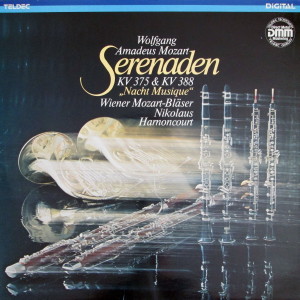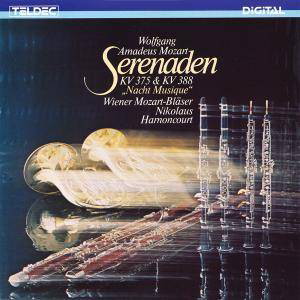 |
1 LP -
6.43097 AZ - (p) 1985
|
 |
| 1 CD -
8.43097 ZK - (p) 1985 |
|
| Wolfgang
Amadeus Mozart (1756-1791) |
|
|
|
|
|
|
|
Serenade Nr. 11 Es-dur, KV
375
|
|
22' 05" |
|
für 2 Klarinetten, 2 Hörner, 2
Fagotte und 2 Oboen
|
|
|
|
- Allegro maestoso
|
8' 34" |
|
A1 |
| - Menuetto
I |
3' 58" |
|
A2 |
| - Adagio |
5' 37" |
|
A3 |
- Menuetto II
|
2' 32" |
|
A4 |
| - Allegro |
3' 24" |
|
A5 |
Serenade Nr. 12 c-moll, KV
388 (384a) "Nacht Musique"
|
|
25' 46" |
|
| für 2 Oboen, 2 Klarinetten, 2
Hörner und 2 Fagotte |
|
|
|
- Allegro
|
11' 42" |
|
B1 |
- Andante
|
4' 08" |
|
B2 |
- Menuetto in Canone
|
3' 47" |
|
B3 |
| - Allegro |
6' 09" |
|
B4 |
|
|
|
|
| Wiener
Mozart-Bläser |
|
| -
Jürg Schaeftlein, Oboe |
|
| -
Gottfried Boisits, Oboe |
|
| -
Alois Brandhofer, Klarinette |
|
| -
Wilfried Gottwald, Klarinette |
|
| -
Milan Turković, Fagott |
|
| -
Wolfgang Kuttner, Fagott |
|
| -
Günther Högner, Horn |
|
| -
Volker Altmann, Horn |
|
|
|
| Nikolaus
Harnoncourt, Gesamtleitung |
|
|
Luogo
e data di registrazione
|
(Luogo
e data di registrazione non indicati)
|
|
Registrazione
live / studio
|
| studio |
Producer
/ Engineer
|
-
|
Prima Edizione CD
|
| Teldec
- 8.43097 ZK - (1 cd) - 47' 51" - (p)
1985 - DDD |
Prima
Edizione LP
|
Teldec - 6.43097
AZ - (1 lp) - 47'
51"
- (p) 1985
- Digital
|
|
|
Notes
|
The features that come out
increasingly in the Salzburg
divertimenti - the
individualization of tone, the
chamber-musical refinement of the
writing and the expression and the
symphonic breadth of the forms -
all this is realized in the Vienna
serenades in a synthesis of styles
and traditions that takes a different shape in
each work. The first of the
“series” is the Serenade, or, as
the autograph manuscript reads,
“Gran Partitta” K. 361 (370a). It
was followed by K. 375, written in
October 1781 for the sister-in-law
of the court painter Joseph Hickel for
St. Theresa’s Day (15th October).
K. 375 returns to the normal
serenade plan of five movements as
against its predecessor's seven,
and is written for a more
modest-sized ensemble; in sound,
however, it is no less symphonic
than the older sister-work, and
compensates for the reduced
tonality of its scoring by
stricter motif work and further
refinement of the writing. Mozart
was keen that the work should
please the valet and personal
cellist of the Emperor, Herr von
Strack - Mozart knew von Strack
himself, who was a frequent guest
of Frau Hickel -
and it was chiefly for this reason
that he wrote it “with a modicum
of good sense”, as he termed it. The original
version was scored for two
clarinets, two bassoons and two
horns; the composer added two
oboes in July
1782, A ten-part arrangement,
which may be even later in date, with two cor
anglais, has been lost.
Mozart’s last wind serenade, the
“Nacht-Musique”, as he calls it in
a letter, belongs absolutely among
the most subtle chamber music of
the mature composer. K. 388 was
written at the end of July 1782 for the
private orchestra of either Prince
Schwarzenberg or Prince
Liechtenstein. It was not without
reason that Mozart subsequently
(probably in 1787) chose to
arrange this work as a string
quintet, for the musical substance
and design were able to remain
almost unchanged: here,
instrumentation and tone-colour
retain only minimal intrinsic
value: they are merged for the
most part in the exceptional
strictness of the writing. The
four-movement form of the work,
even moreso the canonic minuet, which is
quite out of place in a serenade,
is pure chamber music. The most
sophisticated and profound
territory of Mozart’s music is
occupied by the uncompromising,
almost overloaded strictness of
the musical language and the
unrelentingly sombre atmosphere
that permeates the entire work
(note that the key, C minor, is
that of the Mass K. 427 and the
Piano Concerto K.
491), only giving way at the last
minute, in the coda of the finale,
to a cheering C major outlook on
to traditional Serenade pastures.
Translation: Clive
Williams
|
|
Nikolaus
Harnoncourt (1929-2016)
|

|

|
|